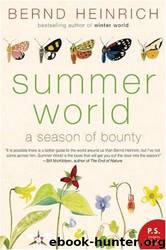Summer World: A Season of Bounty by Bernd Heinrich

Author:Bernd Heinrich
Language: eng
Format: mobi
Tags: Plants, Animal behavior, Life Sciences, Animal-plant relationships, Animals, Nature, Science, Animals - Summering, Wildlife, General, Ecology, Summer - New England, Summer, Seasons, Adaptation (Biology), Animals - Habitations, Essays
ISBN: 9780060742188
Publisher: HarperCollins
Published: 2010-03-24T01:21:05.861408+00:00
12
New England Longhorns
23 July 2005. TODAY I FOUND SEVERAL FOOT-LONG LIVE oak twigs on the ground under the tree I had planted about fifteen years ago next to the cabin. How could they possibly have broken off? Looking at the breaks, I see a circular groove; they have been girdled, as though by a sharp knife. There is nobody else here, and they came off from near the top of the tree. I wonder what happened, and I sketch what I see. Is it a sign of a longhorn?
LONGHORNS ARE AN IMPRESSIVELY LARGE AND DIVERSE group, and they are not exclusive to Texas. They are certainly more interesting than those notorious longhorns that are sliced and served at restaurants. I’m talking about longhorn beetles, of course—those that go by the family name of Cerambycidae. You need a field guide to identify most of them, and my guide with color plates, by Douglas Yanega, which is restricted only to those of New England, lists 344 species. All have long curved “horns” (antennae). Body markings vary from pastel browns, grays, and black to garish yellows, blues, and orange-red. The colors are arranged in all sorts of intricate stripes and patches. I don’t think I’ve seen more than a dozen or two dozen species, although some can’t be missed. The adults in one group of species feed on flowers in the clearing around my cabin in the Maine woods. In most other species the adults don’t feed at all. The larvae of many species eat bark and wood, and make themselves conspicuous by their feeding “tracks,” which you see inscribed (along with those of some other insects) on the surface of logs when you peel off loose bark.
Although most longhorn beetles don’t feed as adults, their larvae can be a nuisance or even a menace to trees. However, this situation could be worse—most trees have evolved defenses against longhorns, which are one of their main enemies. For example, balsam fir trees exude sticky resin when their bark is injured, and any beetle grub attempting to enter the body of the tree will be immediately challenged by a chemical counterattack of sticky, unsavory petrochemical-scented resin. In turn, the beetles have evolved a more nuanced attack. They wait until a tree is dying or very recently dead and defenseless before they lay eggs on it, and their larvae can start to eat the still moist and as yet unspoiled carcass. Indeed, longhorn beetles have an uncanny ability to detect the smell of death and injury on a tree, because invariably in the summer when I chop down a pine, fir, or spruce, one group of these beetles, the sawyers, Monochamus, come flying in—within minutes! Undoubtedly the beetles’ chemical sensors, arrayed on their “horns” (which are a little longer than body length in females or more than twice body length in males), are attuned specifically to chemicals in pitch, and in the case of the males, presumably also to the females’ scent.
The larvae that hatch from the sawyers’ eggs burrow under the bark and later bore into and through the wood.
Download
This site does not store any files on its server. We only index and link to content provided by other sites. Please contact the content providers to delete copyright contents if any and email us, we'll remove relevant links or contents immediately.
Sapiens: A Brief History of Humankind by Yuval Noah Harari(13122)
The Tidewater Tales by John Barth(12047)
Do No Harm Stories of Life, Death and Brain Surgery by Henry Marsh(6350)
Mastermind: How to Think Like Sherlock Holmes by Maria Konnikova(6274)
The Thirst by Nesbo Jo(5821)
Why We Sleep: Unlocking the Power of Sleep and Dreams by Matthew Walker(5680)
Sapiens by Yuval Noah Harari(4578)
Life 3.0: Being Human in the Age of Artificial Intelligence by Tegmark Max(4540)
The Longevity Diet by Valter Longo(4466)
The Rules Do Not Apply by Ariel Levy(3938)
The Body: A Guide for Occupants by Bill Bryson(3858)
The Immortal Life of Henrietta Lacks by Rebecca Skloot(3843)
Why We Sleep by Matthew Walker(3798)
Animal Frequency by Melissa Alvarez(3771)
Yoga Anatomy by Kaminoff Leslie(3726)
Barron's AP Biology by Goldberg M.S. Deborah T(3646)
The Hacking of the American Mind by Robert H. Lustig(3601)
All Creatures Great and Small by James Herriot(3542)
Yoga Anatomy by Leslie Kaminoff & Amy Matthews(3420)
